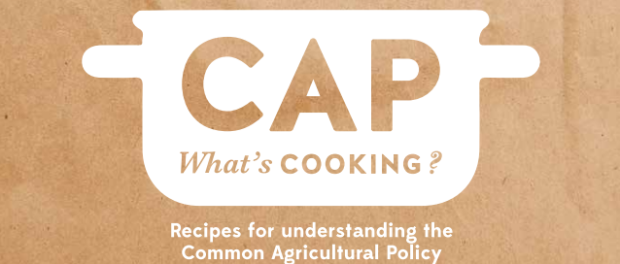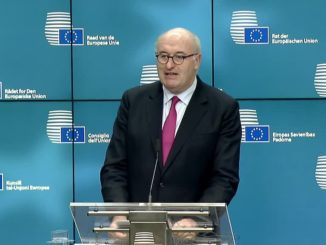ARC2020 Coordinator Samuel Féret gives us a veritable cook book of the CAP – one that may have a master template, but with very varied national and regional editions. He also introduces some changes he’d like to see in Europe’s farming policy.

When it comes to discussing CAP reform, the debate runs on for years after the European agreements have been signed. It covers numerous aspects of the implementation of previous measures and it prepars the ground for further reforms five or six years ahead. Discussion of the CAP regularly agonises over its finality, its scope, its coherence, both internally and externally, not to mention the effectiveness of its huge annual expenditure, which total around EUR 55 billion a year.
But many of those involved, both directly and indirectly, underestimate the inertia of implementing the CAP at national and regional levels. They believe that Brussels is the wheelhouse from which CAP is steered. There is a persistent belief that by establishing the right balance of power between public sector policymakers and stakeholders, it should lead to a CAP that matches their vision. More sustainable; more competitive; greener; fairer; perhaps simpler, too. There is no shortage of vision in their expectations.
Due to the nature of the process, each successive reform of the CAP has come with unfulfilled promises. The reformed 2013 CAP pledged a new partnership between European citizens and the farming sector to address the challenges of food security; to make better and more sustainable use of natural resources, as well as growth for the rural economy. Ahead of the 2017-2019 talks on the CAP, we offer our first impressions of how member states have developed distinct national versions of the CAP – notwithstanding that all 28 signed the same agreement.
Cross-border compromises meant that a vision of what was achievable for European agriculture collided with the existing sectorial and national interests of existing CAP beneficiaries. It was a classic case of déjà vu. In the past we have called it the de-Europeanisation of the CAP: since the direct payments are funded by Brussels, we can hardly talk of re-nationalisation.
The Council and the European Parliament only decide part of the CAP – notably the areas it covers and the rules by which the game is to be played. This leaves national governments to decide the extent, the intensity and the degree of progressive thinking that will go into the changes they oversee. Thus, national governments have full responsibility for delivering CAP reforms. Or not, as the case may be.
The June 2013 agreement on the CAP covered four fundamental frameworks, of which two were subjected to intensive negotiations. Direct payments and rural development were discussed exhaustively by administrators and agricultural stakeholders, to define the ways in which these aspects of the Common Agricultural Policy were to be implemented on the ground and in the sectors concerned.
To put it simply, each government cooked up its own policy, choosing from the ingredients on offer in the CAP menu. They worked with what was on offer, but each arrived with a recipe that had been decided in advance. The 2013 CAP was an à la carte affair that spawned 32 national variations for direct payments, once national regimes in Wales, Scotland and Northern Ireland had been taken into account, alongside the Belgian regional governments. Once the 118 rural development programmes had been added to the list, stakeholders in this phase of the CAP could pick and choose from a long and extensive menu.
The order in which different elements of the policy are implemented is crucial, since it determines choices made by the managing authorities and sets their priorities between now and 2020.
At a national level, the implementation can include a period of discussion and debate among stakeholders – but this depends on the good will of whoever has to deliver the policy objectives. In some rare cases, civil society has a voice in kitchen cabinet discussions alongside agricultural professionals. However in the best cases, civil society is only ever consulted on rural development programmes and not on the direct payments which account for three quarters of the spending.
Read: the #AfterCAP Debate in full
However, for each reform to be accepted on the ground and implemented in the spirit of the European agreement, it should be based on a wider social basis, extending beyond the administrators and the agricultural world.
At a European level, the reforms agreed in 2013 provided for a fairer and greener CAP. However, the agreement left a bitter taste for agricultural organisations and nature conservation organisations, particularly in the level of the demands imposed by the ecological component of the direct payments.
There are better ways to make compromises, but the only way to induce change into the CAP is to introduce changes to the rules, either in response to specific circumstances (eg sections of the Common Market Organisation) or by adding new criteria at the start of the new phase of the CAP (eg the greening of direct payments). Otherwise, there is an extra option of giving national and regional governments ample room for manoeuvre, as happened in the June 2013 agreement. In this case there was more flexibility for implementing a fairer, greener CAP – or not, as administrations saw fit.
The success of a policy is measured by its implementation. For a year and half now, the CAP has been running on a test bench and assessed by its users, national and regional authorities for the most part, but also with input from numerous other assessors, since several reports are expected between 2017 and 2018 on the levels of socio-economic and environmental performance of the CAP. In the years after 2020, the CAP will reflect the lessons learnt from all the different national and regional menus.
At a national level, the CAP footprint follows a form of path dependency. To a certain extent, governments like to cook up their own agricultural policies using CAP funding. A growing number of them, indeed a majority now, like coupled payments to the animal sector. Equally, Member States are very greedy when it comes to getting away from the European recipe for greening. They have given themselves a free hand to make greening complicated and render it indigestible by introducing national ingredients, such a environmental certification, derogations and the like. Finally, only eight Member States opted to try distributive payments to target support for specific categories of holding including the small and medium ones.
Therefore, to better appreciate the flavour of the CAP, it is vital to leave the institutional triangle comprising the European Commission, the Council and the European Parliament to test and taste the national recipes. The CAP is negotiated by governments and not states, so the outcomes reflect their political parentage.
It is all too easy to follow the trend of framing the CAP within that classic EU institutional triangle with unevenly matched sides and full of obstacles.
What is more, this political logic has percolated through to the policymaking kitchens of the European Parliament. If this has reflected a degree of “institutional democratisation” since the Lisbon treaty the 2013 CAP reform showed that members of the European Parliament often voted along regional or national lines, usually following the instructions of their national governments.

The CAP is like a culinary work of art, in which farm ministers work like chefs in a kitchen, preparing policies to feed to the agricultural sector. They work surrounded by the European common rules, their staff and farming unions. Even if the European agreement imposes new recipes, the finished dish will bear an uncanny resemblance to previous versions. It’s an (agri)cultural heritage. As with the implementation of the 2013 CAP reform or the next one after 2020, EU farm ministers might take the destiny of the CAP in hand. Much as they did informally when they met at Chambord in France on September 2 to stand for no « CAP-exit » after the UK vote on Brexit.
Yet when ministries make and revise public decisions about the CAP, they do so as head chefs in their own kitchens. This is exactly the place to be at every time, for negotiating good recipes for a fairer and greener CAP.
When it comes to the first European common policy after 2020, a new partnership between European citizens and the farming sector includes following steps forward before 2020:
- Better targeting of income support towards on-farm employment and young farmers, especially through both redistributive payment on first hectares and capping for higher amounts;
- No extra exemption, derogation nor certification to the common Greening rules – these are designed to change current unsustainable farming practices. Pesticides must be banned from Ecological Focus Areas ; in addition real agroecological infrastructures and agroforestry need to be brought into the core of greening;
- Money transfer above 10 % shifted from Pillar 1 to Pillar 2 in order to support the agroecological transition in all territories through cooperation, innovation, renewal of generations and agrienvironmental schemes
Triangle CAP negotiations in Brussels seems like only first half time of game of football. The second half of the CAP reform is played by members states at national level. The outcome of the competition depends on how much the CAP has been implemented on the ground.
More
CAP What’s Cooking? Recipes for understanding the Common Agricultural Policy, co-edition Groupe de Bruges/Slow Food Youth Network.
Read the first contribution to the #AfterCAP debate from Jan Douwe Van Der Ploeg
#AfterCAP | Towards an integrated rural development policy 2.0





